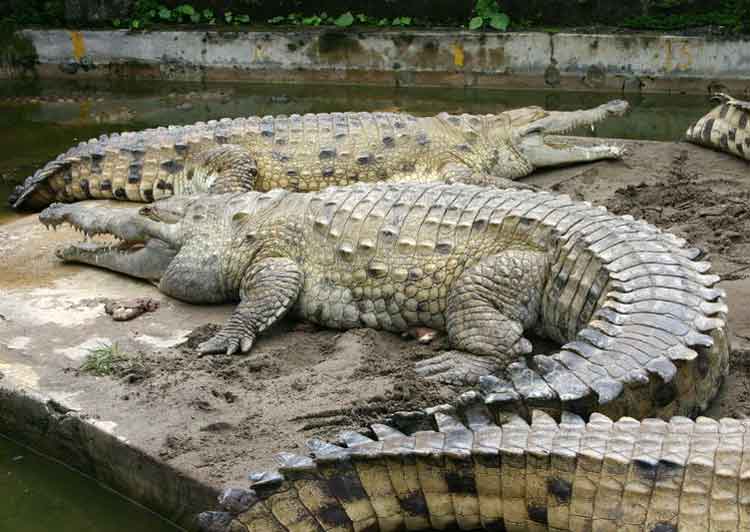Crocodylus intermedius (*) Cladus: Eukaryota Name Crocodylus intermedius Graves, 1819 Type locality: Unknown Holotype: MNHN 7512 Synonyms * Crocodilus intermedius Graves, 1819
* Graves, M. L. 1819. Sur deux nouvelles espèces de crocodile. Ann. Gen. Sci. Phys. Bruxelles 2: 343-353.
The Orinoco Crocodile, Crocodylus intermedius, is a critically endangered crocodile found in freshwater in northern South America, in particular the Orinoco River. Typical measurements for adults range from 3 to 4.8 m (9.9-16 ft). Typical weight for mature females is 200 kg (440 lbs) and 380 kg (837 lbs) for males.[1] The largest specimen reported was shot in 1800 and allegedly measured 6.6 m (22 ft). This was unconfirmed and modern Orinoco Crocodiles are not thought to exceed 5 m (16.5 ft).[2] The Orinoco Crocodile can be recognised by its relatively long snout and its yellowish hide with dark brown bands. It is restricted to the Orinoco River drainage basin and the Meta River drainage basin in Colombia and Venezuela. They have been occasionally reported on the island of Trinidad, but this has not been confirmed and witnesses may have mistaken an American crocodile for the rarer species. The Orinoco Crocodile mates during the drier period of the year and usually 14 weeks after mating, the female crocodile will dig a nest. It is a hole-nester and usually makes the nest on a sand bank. The eggs incubate for around 3 months. During the night they hatch and call to their mother who digs them out of the nest and carries them to the water. The young are defended by their mother for a year. Young Orinoco Crocodiles are often at risk from American Black Vultures, tegu lizards, anacondas, caimans, and other carnivores. The Orinoco Crocodile is highly endangered due to excessive hunting for its hide. During the 1940s to the 1960s, literally thousands of these animals were slaughtered in the Orinoco River and the Llanos wetlands, and the species came very close to extinction. The Orinoco Crocodile was given protected status in the 1970s. Today it is protected both in Venezuela and Colombia, and also included on Appendix I by CITES. In addition to hunting for its hide, more recent threats also include the collection of juveniles for sale in the live animal trade, pollution, and the proposal of a dam in the upper Orinoco River region. It is unclear how many individuals remain in the wild, but estimates range between 250-1500 individuals. The population in Colombia is very low, with the largest sub-population estimated at around 50 individuals in the Casanare area. The largest sub-population in Venezuela is in Cojedes and Sararé, with less than 500 adults remaining. A number of other smaller sub-populations exist. In November 2007, 50 individuals were held in zoos registered by ISIS, of which the largest population, 35 individuals, were kept in the Dallas World Aquarium. Additionally, a large number of individuals are held at captive breeding facilities in Venezuela. Since the early 1990s, a large number of hatchlings have been released both into private ranchlands (especially in the Llanos where nature oriented tourism is important for the local economy) and in national parks in Venezuela. As many hatchlings die before reaching adulthood, 360 captive bred individuals have been released only after reaching a length of 2 m (6½ ft). Diet Like all crocodilians, the majority of the Orinoco Crocodile's diet consists of fish, but as an opportunistic apex predator virtually any animal living within its range could be considered a potential meal for a large adult (including Capybara, domestic animals, and even occasionally other large predators if food is scarce.) There have been reports of attacks on humans, but this is highly unlikely given the extremely low population level of the species and its relative isolation from large human settlements References 1. ^ http://www.arkive.org/orinoco-crocodile/crocodylus-intermedius/facts-and-status.html * Crocodile Specialist Group (1996). Crocodylus intermedius. 2006. IUCN Red List of Threatened Species. IUCN 2006. www.iucnredlist.org. Retrieved on 09 May 2006. Listed as Critically Endangered (CR A1c, C2a v2.3) Source: Wikipedia, Wikispecies: All text is available under the terms of the GNU Free Documentation License |
|

